
Reducing the Carbon Footprint of the Timber Industry
The timber industry plays a vital role in providing renewable and sustainable materials for construction, furniture, and paper production. However, the industry’s carbon footprint can be significant, ranging from energy-intensive manufacturing processes to the potential impacts of forestry operations. As the world seeks to combat climate change, it is essential for the timber industry to take proactive steps to reduce its environmental impact and lead the way towards a more sustainable future.
Sustainable Forest Management
At the core of the timber industry’s sustainability efforts lies responsible forest management. Sustainable harvesting practices are crucial to double-check that the long-term health and resilience of forest ecosystems. Selective logging, where only mature or damaged trees are removed, can minimize disruption to the forest and promote natural regeneration. Reforestation and afforestation efforts help replenish harvested areas, while biodiversity conservation strategies protect critical habitats and support the overall ecological balance.
Careful planning and execution of forestry operations are key to reducing the industry’s carbon footprint. By optimizing harvest planning, minimizing soil disturbance, and implementing efficient logging techniques, the timber industry can significantly reduce greenhouse gas emissions associated with its activities. Additionally, the selection of tree species and the management of forest age classes can have a profound impact on the overall carbon sequestration potential of the forest.
Environmental Impact Assessment
To fully understand the environmental impact of the timber industry, it is essential to conduct comprehensive life cycle analyses (LCA) of its operations. These assessments examine the greenhouse gas emissions generated throughout the entire supply chain, from harvesting and transportation to manufacturing and product disposal. By identifying hotspots and opportunities for improvement, the industry can develop targeted strategies to reduce its carbon footprint.
Effective waste management practices are also crucial in minimizing the environmental impact of the timber industry. Exploring innovative ways to recycle, reuse, or repurpose wood waste and by-products can not only reduce landfill disposal but also generate additional value from otherwise discarded materials.
Technological Innovations
Embracing technological advancements can play a pivotal role in reducing the timber industry’s carbon footprint. Energy-efficient manufacturing processes, the adoption of alternative fuel sources, and the integration of renewable energy solutions can significantly lower the industry’s direct emissions. Furthermore, the development of advanced logging equipment and automated systems can enhance operational efficiency, minimize waste, and optimize transportation logistics.
The exploration of biomass utilization is another promising avenue for the timber industry to reduce its environmental impact. By converting wood waste and residues into biofuels or energy sources, the industry can reduce its reliance on fossil fuels and divert materials from landfills.
Supply Chain Optimization
Optimizing the timber industry’s supply chain can yield substantial benefits in terms of carbon reduction. Streamlining logistics and transportation operations, such as route planning and vehicle efficiency, can minimize fuel consumption and associated emissions. Additionally, embracing circular economy principles by encouraging the reuse, repair, and recycling of timber products can help mitigate the industry’s overall environmental impact.
Renewable and Recyclable Materials
The timber industry’s inherent advantage lies in the renewable and recyclable nature of its primary raw material – wood. By promoting the use of wood-based construction materials, the industry can leverage the carbon-storing capabilities of timber and displace the use of more emissions-intensive alternatives, such as concrete and steel.
Exploring the potential of biomass as a sustainable energy source and raw material for various products can further enhance the industry’s environmental credentials. The efficient utilization of wood waste and residues can contribute to a more circular and low-carbon economy.
Policy and Regulations
Supportive policies and regulations play a crucial role in driving the timber industry towards a lower-carbon future. Carbon pricing mechanisms, such as emissions trading schemes and carbon taxes, can incentivize the industry to adopt more sustainable practices and invest in technological innovations. Similarly, ambitious emission reduction targets set by governments and industry bodies can provide a clear roadmap for the industry to align its operations and strategies.
Incentives and subsidies for sustainable forestry practices, renewable energy investments, and circular economy initiatives can further encourage the timber industry to prioritize environmental sustainability.
Stakeholder Collaboration
Achieving significant reductions in the timber industry’s carbon footprint requires a collaborative effort among various stakeholders. Industry partnerships can facilitate the sharing of best practices, the development of innovative solutions, and the standardization of sustainability metrics. Engaging with local communities, environmental groups, and policymakers can also help the industry address concerns, incorporate diverse perspectives, and align its operations with the broader societal goals of environmental protection and climate action.
Education and Awareness
Educating and empowering the timber industry’s workforce is essential for driving sustainable change. Employee training programs on energy efficiency, waste management, and sustainable forestry practices can equip the industry’s workforce with the necessary knowledge and skills to implement effective carbon-reduction strategies.
Investing in public outreach and awareness campaigns can also help the timber industry showcase its sustainability efforts, dispel misconceptions, and garner support from consumers and the wider community. Fostering a culture of environmental stewardship and innovation within the industry can further propel the development and adoption of cutting-edge solutions.
By embracing a holistic approach to sustainability, the timber industry can lead the way in reducing its carbon footprint and contributing to a more sustainable future. Through the adoption of responsible forestry practices, the implementation of innovative technologies, the optimization of supply chains, and the fostering of collaborative partnerships, the industry can position itself as a model of environmental stewardship and climate-conscious operations.
Visit Forestry Contracting to learn more about the latest advancements and best practices in the timber industry.
Tip: Inspect stand health regularly for signs of pest infestation or disease

